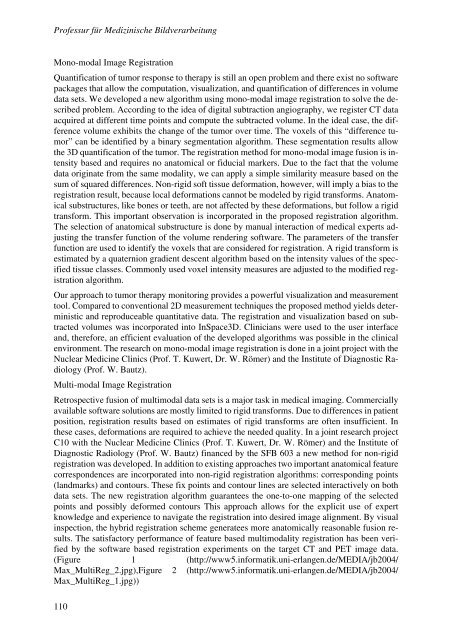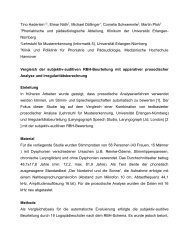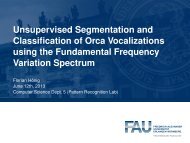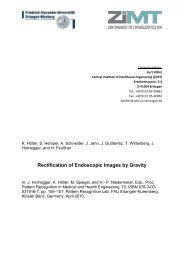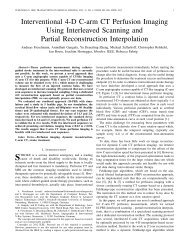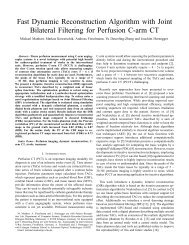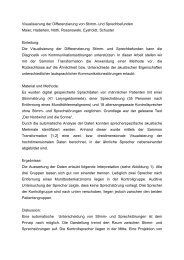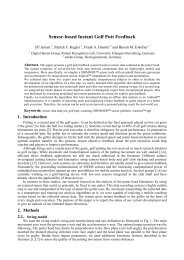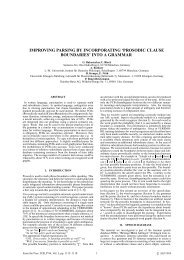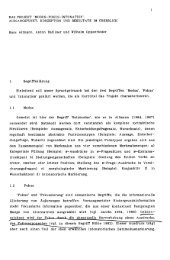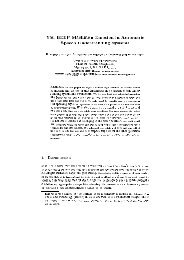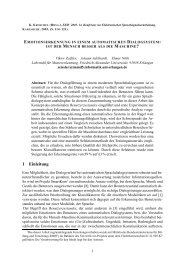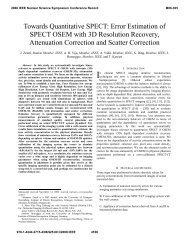Lehrstuhl für Informatik 5 (Mustererkennung)
Lehrstuhl für Informatik 5 (Mustererkennung)
Lehrstuhl für Informatik 5 (Mustererkennung)
Erfolgreiche ePaper selbst erstellen
Machen Sie aus Ihren PDF Publikationen ein blätterbares Flipbook mit unserer einzigartigen Google optimierten e-Paper Software.
Professur für Medizinische Bildverarbeitung2.8Mono-modal Image RegistrationQuantification of tumor response to therapy is still an open problem and there exist no softwarepackages that allow the computation, visualization, and quantification of differences in volumedata sets. We developed a new algorithm using mono-modal image registration to solve the describedproblem. According to the idea of digital subtraction angiography, we register CT dataacquired at different time points and compute the subtracted volume. In the ideal case, the differencevolume exhibits the change of the tumor over time. The voxels of this “difference tumor”can be identified by a binary segmentation algorithm. These segmentation results allowthe 3D quantification of the tumor. The registration method for mono-modal image fusion is intensitybased and requires no anatomical or fiducial markers. Due to the fact that the volumedata originate from the same modality, we can apply a simple similarity measure based on thesum of squared differences. Non-rigid soft tissue deformation, however, will imply a bias to theregistration result, because local deformations cannot be modeled by rigid transforms. Anatomicalsubstructures, like bones or teeth, are not affected by these deformations, but follow a rigidtransform. This important observation is incorporated in the proposed registration algorithm.The selection of anatomical substructure is done by manual interaction of medical experts adjustingthe transfer function of the volume rendering software. The parameters of the transferfunction are used to identify the voxels that are considered for registration. A rigid transform isestimated by a quaternion gradient descent algorithm based on the intensity values of the specifiedtissue classes. Commonly used voxel intensity measures are adjusted to the modified registrationalgorithm.Our approach to tumor therapy monitoring provides a powerful visualization and measurementtool. Compared to conventional 2D measurement techniques the proposed method yields deterministicand reproduceable quantitative data. The registration and visualization based on subtractedvolumes was incorporated into InSpace3D. Clinicians were used to the user interfaceand, therefore, an efficient evaluation of the developed algorithms was possible in the clinicalenvironment. The research on mono-modal image registration is done in a joint project with theNuclear Medicine Clinics (Prof. T. Kuwert, Dr. W. Römer) and the Institute of Diagnostic Radiology(Prof. W. Bautz).Multi-modal Image RegistrationRetrospective fusion of multimodal data sets is a major task in medical imaging. Commerciallyavailable software solutions are mostly limited to rigid transforms. Due to differences in patientposition, registration results based on estimates of rigid transforms are often insufficient. Inthese cases, deformations are required to achieve the needed quality. In a joint research projectC10 with the Nuclear Medicine Clinics (Prof. T. Kuwert, Dr. W. Römer) and the Institute ofDiagnostic Radiology (Prof. W. Bautz) financed by the SFB 603 a new method for non-rigidregistration was developed. In addition to existing approaches two important anatomical featurecorrespondences are incorporated into non-rigid registration algorithms: corresponding points(landmarks) and contours. These fix points and contour lines are selected interactively on bothdata sets. The new registration algorithm guarantees the one-to-one mapping of the selectedpoints and possibly deformed contours This approach allows for the explicit use of expertknowledge and experience to navigate the registration into desired image alignment. By visualinspection, the hybrid registration scheme generatees more anatomically reasonable fusion results.The satisfactory performance of feature based multimodality registration has been verifiedby the software based registration experiments on the target CT and PET image data.(Figure 1 (http://www5.informatik.uni-erlangen.de/MEDIA/jb2004/Max_MultiReg_2.jpg),Figure 2 (http://www5.informatik.uni-erlangen.de/MEDIA/jb2004/Max_MultiReg_1.jpg))110


